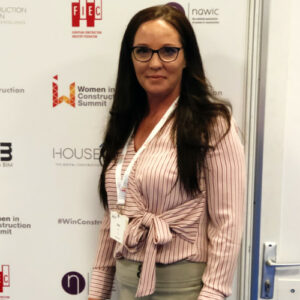Manchester's retrofit event 2021

“For a viable market,” Total Flow consultant Tim Hall, “you need sustained demand and you need capable suppliers.
As ever, our panellists were tackling the difficult question of scaling up retrofit at the local level, this time in Manchester.

Tim Hall, Total Flow: “I think where Manchester council and housing associations can have an impact,” Tim continued, “is where they say, ‘we have a commitment to this and this is what it means in terms of our pipeline of work.”
“Manchester can set that clear vision and back it up with a roadmap which others can get involved with. That will attract green investment, and that will help the deliverers and manufacturers grow.”
Green revolution with people at its heart
Manchester is one of the best examples of a council setting out this kind of vision, we learnt during the conference.
“Manchester has made a bold but realistic and evidence-based economic recovery bid to the government in its Manchester Economic Recovery Plan,” Manchester city council’s executive member for housing and regeneration Councillor Suzanne Richards told attendees.
“In the plan, we have put forward a demand for £290 million for four key housing-related priorities.”

Cllr Suzanne Richards, Manchester City Council (host partner) then outlined what these priorities were. “We want to launch a long-term affordable housing retrofit programme, and to sit alongside that with an intermediary labour market and social value benefits programme. We’ve bid for around £260 million which will retrofit 10,500 social homes across Manchester.
“Secondly, we want to invest in initiatives which make Manchester net-zero by 2050. Our third priority is developing grassroots initiatives involving young people, local residents and the voluntary and community sector in zero carbon activities. Finally, we want to support demonstration projects which prove concepts around technologies and business models.”
“As we start to emerge from the dark days of this pandemic,” Cllr Richards concluded, “we want Manchester to become the engine room for another industrial revolution — but this time a green revolution with people at its heart.”
Jonny Sadler, Deputy Director for the Manchester Climate Change Agency, provided some invaluable context around Manchester council’s ambitions.

“The Manchester Climate Change Framework 2020-25 has an objective of the city emitting a maximum of 15 million tonnes of CO2 from our homes, workplaces and ground transport from 2018,” Jonny explained. “That means reducing our CO2 emissions by at least 50% between 2020 and 2025.”
“We need to retrofit the 226,640 homes we’ve got,” Jonny spelled out. “That equates to retrofitting 11,500 homes every single year.”
Jonny also emphasised the socio-economic benefits of retrofit. “Ten people every day die prematurely in Greater Manchester from poor air quality, and it’s quite often those people from disadvantaged neighbourhoods who experience those impacts. This is about placing socio-economic benefit right at the heart of the city’s ambitious move to zero carbon.”
To help move retrofit forward, Jonny provided a very useful overview of the Manchester organisations contributing to the city’s carbon emissions.
“We have established a mechanism that enables the Manchester Climate Change Agency to have a direct relationship with different sources of the city’s emissions. We currently have 60 organisations from 11 sectors, with collective responsibility for over 20% of the city’s direct carbon emissions, and with a level of influence over the remaining 80%.”
£1.7bn over 17 years
Among those organisations Jonny cited were social housing providers, and our panellists agreed that this sector was a good place to start to move retrofit forward for environmental and commercial reasons.
“About 30% of Manchester’s emissions come from domestic stock, and around 5% of those direct emissions come from the city’s social housing stock,” Jonny said. He pointed towards the Agency’s Manchester Housing Providers Partnership, which links registered housing providers in Manchester and the council in partnership to facilitate local delivery on key strategic themes, as a possible route for getting retrofit going.

Matt Roberts, Strategic Director of Property and Development at housing provider Southway Housing Trust, gave us invaluable insight into the commercial opportunities of retrofitting social housing.
“An exercise we conducted on Manchester came up with around £24,500 per property for retrofit works,” Matt recounted. “That’s a £1.7bn investment over the next 17 years across the city.”
We like a challenge,” Matt said. “There’s things like the Social Housing Decarbonisation Fund but we recognise the need for more innovative funding. We have the proven skills to deliver large-scale programmes — like Community Energy Saving Programme (CESP) and solar PV. And many of us have the in-house workforces who can adapt to have the necessary skills. Help us train our workforce.”
Portacabin outlook
Kirsti Wells, Business Development Manager at Cadcoe, highlighted the challenges surrounding skills and employment for kickstarting retrofit. “There’s a real problem with losing talent to other areas of the country, like London.

“The rate of retirement is also forecast to increase as 22% of the workforce are over 50 and 15% are in their 60’s,” she continued. “And the number of women working in construction trades is just 1-2%.”
But the biggest barrier was a misconception surrounding the construction sector. “One of the major challenges is that we don’t know what many of those roles are going to be. They change. The digital revolution is taking us towards offsite manufacturing. There’s a huge buzz around it, people want to get involved. But from education upwards do they actually know what it is?”
“The education sector doesn’t necessarily know what off-site construction is. There’s still that portacabin outlook — it’s still very much a hard hat and high viz mentality!” Kirsti joked.
“Industry has a responsibility to go into schools, talk to students and use our platforms like social media to tell them about these things and guide them in the right direction.”
Best practices
A number of our panellists provided pointers on retrofit best practice, particularly for social housing providers.
Mark Arnold, Head of Technical Strategic Assets at Thirteen Housing Group, provided insight on decarbonisation project management practices.

“The start of our project was to create a baseline to understand the needs of the organisation for the next 30 years and the impact that would have, so we had an understanding of the financial implications of our endeavours.”
“To do this we engaged with an estate agent to carry out stock condition surveys, detailed energy assessments to give us a full breakdown by archetype of heat demands, energy usages of the properties, and also a wider holistic estate survey. These enabled us to put a pound sterling per square metre cost for those improvements.
From this we also got an overview of government policies, a review of our stock condition and a net zero carbon study.”
“We then needed to plan out what we needed to do for the next 30 years to achieve our net zero goals,” Matt continued. “We developed three phases for decarbonising our stock. Phase one was a fabric first approach, phase two was to balance which links to decarbonisation of the grid, and phase three looked at energy generation through things like solar PV.”
“We then decided to build on these foundations. We turned the estate agent’s assessments into a 30-year investment plan at the property level. We developed a toolkit of interventions, modelled a platform which calculates thermal improvements and carbon reductions, and we carried out accurate surveys of the building design types.”
Matt also ran us through the process his company went through to renovate a bungalow. “Vacuum perforation caused an issue from day one. Not putting it in internally is potentially something to consider,” he described. “The ventilation was a necessity because heat humidity increased significantly with the new thermal blanket around the property.”
Some of our panellists suggested smart retrofit as being key to ensure good quality retrofit works. An Internet of Things (IoT) platform was also important, Matt highlighted, “allowing us to have an ongoing understanding of the assets’ performance.”
Jonathan Aktinson of Carbon Coop also stressed the importance of data-driven retrofit.

“Current approaches range from doing what we know is more or less right, to there being too little data — perhaps we’re using EPCs, perhaps we’re using model performance rather than actual performance — and there’s a lack of evaluation there and an understanding of what is or is not working.”
“Data makes retrofit better quality, smarter, and faster,” he said, “and above all, data bridges the gap between the householder and the retrofit provider or installer.” He then explained to attendees how data could improve retrofit assessments, integration and control, and service delivery.
The next debate
During the Q&A, our panel got stuck into the question of measuring energy performance.
“We achieved a 76% reduction in energy usage,” Matt said in reference to some of the properties his housing provider had retrofitted, “but the EPC of the property went from a C to an E. That was because many of the technologies we used don’t have a SAP rating yet,” Matt explained.
“We’ve now moved away from EPCs entirely and now use kW per square metre calculations to understand performance. We do have EPCs as required regulatorily, but we don’t use them for anything else.
Jonathan agreed, opening up an interesting point of debate on the issue of how to measure energy performance.
“I think that’s a really important point Mark makes. In the conversations I’m having, people especially in the public sector are really driven by EPC ratings. It’s the wrong way to influence the retrofit across the market.
“We now look at space heat demand, peak load, and embodied energy as well. There’s a big debate within the industry about embodied energy, where you draw the lines in terms of the materials, in terms of in-use and during construction. That’s the next debate to have!”
Holistic collaborative approach
Another debate our panellists engaged in was what kind of collaboration between the public and private sectors were needed to scale up retrofit. Asked if there was a role for private finance to provide that long-term visibility of market opportunity, Ryan Jude from the Green Finance Institute (GFI) said:

“Absolutely, but it really goes hand in hand with policy. For private finance to develop certain instruments to have confidence to go into markets you need long-term policy frameworks.
“For example, the government’s 600,000 heat pumps per year target by 2028 announced last year has generated lots of interest from manufacturers and banks because they can see that longer term demand,” he explained.
“I think it’s key to remember that private finance can’t cover the entire market. When tackling fuel poverty, you need government intervention around things like carbon pricing. It has to be a holistic, collaborative approach.”
Jonny Sadler had a slightly different take. “We’re not in a space where we should be waiting for national government policy. Yes, national government policy is needed. But there’s a really clear appetite in Manchester that organisations, residents, and communities are ready and willing to go forward on this agenda.”
Retrofit Glossary of Terms
| Term | Definition | Source |
|---|---|---|
| Deep /whole house retrofit | A complete retrofit approach where a house is treated as a joined-up system focusing on building fabric first, to strategies for heating, ventilation and cooling. This ensures that measures work together effectively and efficiently in the long-term. | TrustMark. 2020. Whole House Retrofit – A Consumer Guide. London: BEIS. |
| Fabric first | A retrofit strategy advocating for the building fabric improvements such as insulation as the priority measure. | Institute for Sustainability. 2012. Retrofit insights: perspectives for an emerging industry. London: UCL Energy Institute and Technology Strategy Board. |
| Fuel poverty | Fuel poverty is defined as households who spend 10% or more of their income on domestic energy use, meaning that they cannot maintain an adequately warm home. | Rosenow, J. 2012. Energy savings obligations in the UK – a history of change. Energy Policy. 49, pp. 373-382. |
| PAS 2030:2019 | PAS 2030:2019 is the industry specification (previously PAS 2030:2017) to which all energy efficiency installers must be certified and compliant with when carrying out energy efficiency measures under government initiatives. | TrustMark. 2020. Support for gaining Publicly Available Specifications (PAS) and Microgeneration Certification Scheme (MCS) Certification. [Online]. Available from: https://www.trustmark.org.uk/tradespeople/how-to-become-pas-mcs-certified#questions |
| PAS 2035:2019 | PAS 2035:2019 is the overarching specification for a framework of new and existing standards, promoting a whole house retrofit approach. Once an installer updates their certification to PAS 2030:2019, the PAS 2035:2019 requirements commence. | Elmhurst Energy. 2020. PAS 2035 for Installers. [Online]. Available from: https://www.elmhurstenergy.co.uk/pas-2035-installers |
| Retrofit | The retrospective fitting of building fabric improvements like insulation, low carbon HVAC, such as heat pumps and integrated renewables like PV panels, to improve the energy efficiency, health and comfort of a house and reduce its CO2 emissions. | Putnam, T. 2020. Grassroots retrofit: The role of community-led approaches in the UK’s residential retrofit challenge. Master’s thesis, University of Leeds. |
| Thermal comfort | Thermal comfort is defined as the condition of mind that expresses satisfaction with the thermal environment, and refers to a number of conditions in which most people feel comfortable. | Camuffo, D. 2019. Temperature: A Key Variable in Conservation and Thermal Comfort. In: Camuffo, D. ed. Microclimate for Cultural Heritage. [Online]. 3rd edition. Amsterdam: Elsevier, pp. 15-42. |
Retrofit Glossary creators: Zoe Branford linkedin.com/in/zoe-branford-04372b1ba & Toby Putnam linkedin.com/in/toby-putnam-883b8285 | as part of Low Carbon Homes Project NewGen internship programme
Author

Article written by: Alex King | LinkedIn | Twitter @alexdpking